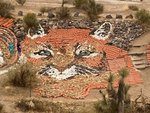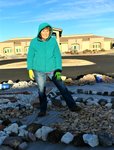






“It’s all here in piles of rock and some of it will come back to life,” Las Cruces artist Kathy Morrow said one chilly morning last December as she continued to work. She is re-creating her animal rock art on a small hill across the road from the New Mexico State University golf clubhouse.
It all began for Morrow in January 2017 as she walked her dog along Tortugas Dam.
Someone had placed a row of small rocks as a border on the east side of the path atop the earthen dam, which is on the northeastern edge of the university golf course. The border grew a little each day and Morrow began to participate, picking a distinct color of rock and watching to see how many new rocks were added past the ones she placed.
Moving down the line a way, Morrow’s artistic instincts took over and she first created a Medicine Wheel (Morrow grew up on the San Carlos Apache Reservation in Arizona). More rock images were inspired by the hawks, roadrunners, lizards, coyotes, dragonflies and other animals she saw during her walks and had been drawing and painting for years as a professional wildlife artist.
Although Elephant Butte Irrigation District (EBID), which owns the dam, didn’t object to the artwork, it was never officially sanctioned and had to be moved before EBID began a recent upgrade to the dam.
With the help of more than a dozen volunteers and a couple of front-end loaders, Morrow spent most of 2022 dismantling her 38 rock animals and moving them about a quarter mile south onto NMSU property.
About 40 tons of rock were moved and more has been added to the new half-acre site that is directly across Herb Wimberly Drive from the golf course club house.
After getting approval from NMSU, Morrow began work on the new project last April.
The first step was clearing the mesquite and creosote bushes from the site and smoothing and packing the dirt. Then, assisted by volunteers, Morrow rolled thousands of feet of fabric down the hill to under lay the rock art and keep it weed free.
She is at the site about 7 a.m. most mornings, using white marble, black cinder, broken terra cotta roof tiles, turquoise crushed glass and red and yellow rocks in many different sizes to recreate the animals she brought to life on the spillway – and add a few new ones.
“I have to wait until the afternoon to see what my morning work looks like because the direction of the sun from the west lights the hill and I can see the animal forms better,” Morrow said.
Because of the gentle downward slope of the hillside, there is a challenge of perspective, she said, so the animals have to be wider at the top and narrower at the bottom.
That “play on illusion and perspective is teaching me more about how extreme I have to distort the animals so they look correct at the view from the bottom of the hill,” Morrow said.
When the project is complete, likely in the spring of 2024, she will have created a cougar measuring 27 feet wide by 35 feet tall, along with a hummingbird, dragonfly, roadrunner, rabbit, bear, horse, horned toad, falcon and eagle that surround the NMSU logo.
Morrow welcomes more volunteers to tote five-gallon buckets of rock around the site, filling in the outlines of animals she has created. You might get to help make a hawk’s wing or a bear’s claw, the red and blue patches behind a roadrunner’s eye or a lizard’s tail.
“I’m creating a giant coloring book outlining the animals and the volunteers are filling in the colors with rocks and tiles and crushed glass,” Morrow said. “I couldn’t do it without volunteer help.”
You can also donate rocks for the project.
“I don’t say no to any rock,” she said.
You can make a monetary donation on Morrow’s website to help pay project expenses, like the weed barrier fabric and 120 bags of concrete to fill the hollow roof tiles.
Visit www.kathymorrowstudio.com.